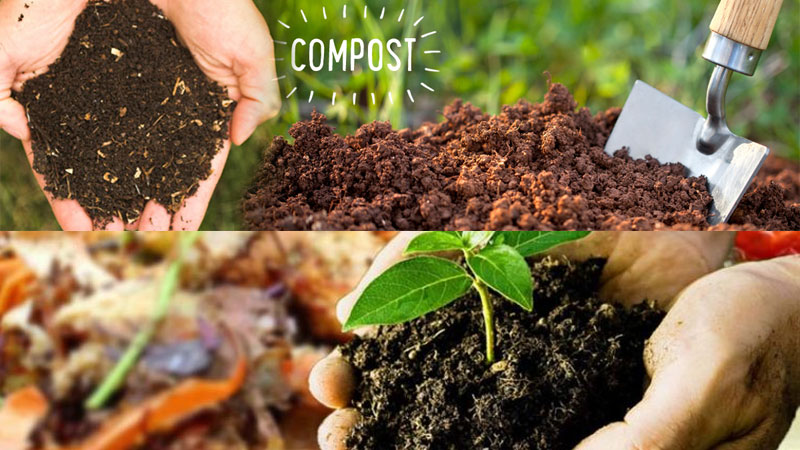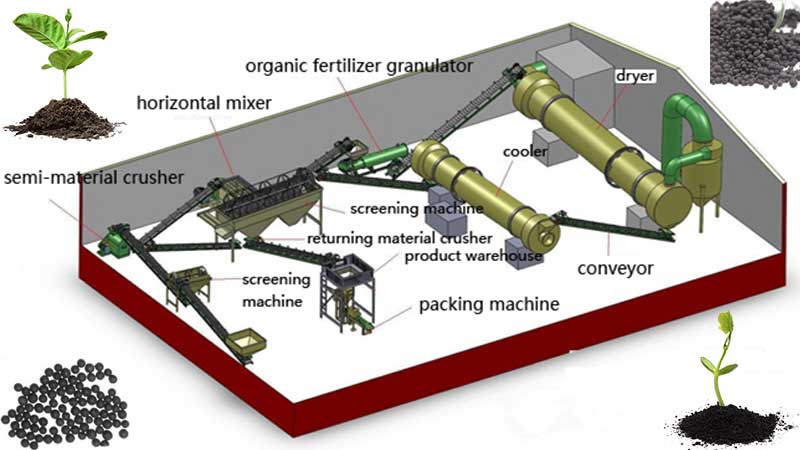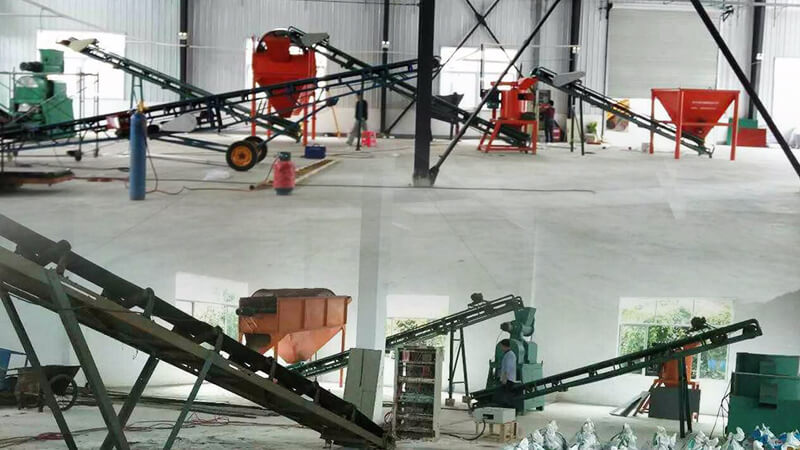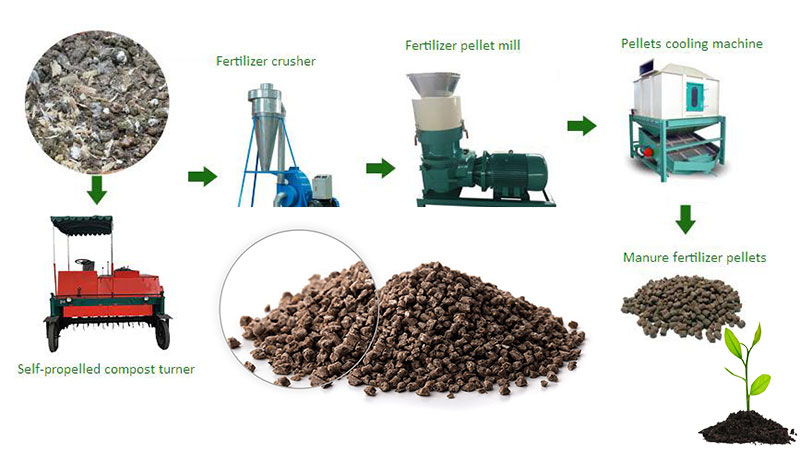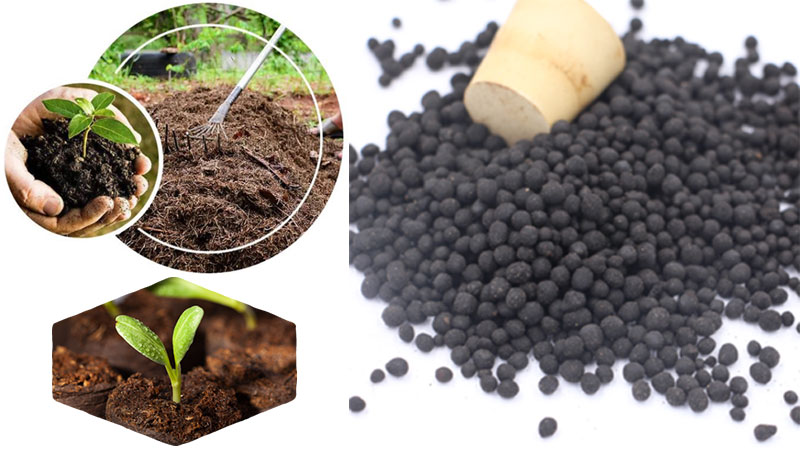How to Compost Waste?
Organic waste composting is necessary and inevitable when households make your own fertilizer at home. Composting waste is also an efficient and economic way in livestock waste management. There are 2 kinds of composting methods available in homemade organic fertilizer process.
1. General Composting
Temperature of general compost is less than 50℃, having a longer composting time, usually 3-5 months. There are 3 piling types: flat type, semi-pit type, and pit type
Flat Type: suitable for areas with high temperature, much rainfall, high humidity, and high groudwater level. Choosing a dry, open land close to water source & convenient to transport. The width of stack is 2m, height being 1.5-2m, length managing by raw materials quantity. Ramming down the soil before stacking, and covering each layer of materials with a layer of grasses or turfs to absorb oozed juice. The thickness of each layer is 15-24cm. Adding right amount of water, lime, sludge, night soil etc. between each layer to decrease evaporation and ammonia volatilization. Driving self-propelled compost turner (one of the most important composting machine) to turn the stack after one month’s stacking, and so forth, until eventually materials are decomposed. Adding suitable amount of water in accordance with the wetness or dryness of soil. The composting rate varies by season, usually 2 months in summer, 3-4 months in winter.
Semi-pit Type: usually used in early spring and winter. Choosing a sunny and lee site to dig a pit with 2-3 feet depth, 5-6 feet width, and 8-12 feet length. On the bottom and wall of the pit, there should be air passages built in the form of a cross. The top of the compost should be sealed properly with earth after adding 1000 catties dry straws. Temperature will rise after one week’s composting. Using groove type compost turner to turn the fermentation heap evenly after temperature decrease for 5-7 days, then keep stacking until eventually raw materials are decomposed.
Pit Type: 2m depth. It is also called: Underground Type. Stack method is similar to semi-pit type. During the decomposing process, double helix compost turner is applied to turn the material for a better contact with the air.
2. Thermophilic Composting
Thermophilic composting is a principal method to innocuously treat organic materials, especially human wastes. Harmful substances, such as germ, eggs, grass seeds etc. in straws and excretion, will be destroyed after high temperature treatment. There are 2 kinds of composting methods, flat type and semi-pit type. The technologies are same with general composting. However, to speed up the decomposition of straws, thermophilic composting should inoculate high temperature cellulose decomposition bacteria, and establish aeration equipment. The cold-proof measures should be done in cold areas. High temperature compost passes through several stages: Fever-High Temperature-Temperature Dropping-Decomposing. In high temperature stage, harmful substances will be destroyed.
Raw Materials of Homemade Organic Fertilizer
We suggest our customers choose the following types to be your raw materials of homemade organic fertilizer.
1. Plant Raw Materials
(1) Fallen Leaves
In America, in many large cities, governments paid the money for the labour to collect the fallen leaves. After the compost is mature, it will give away or sale to the resident at a low price. It would be best to earth up more than 40 centimeter, unless it is in the tropical. And in each layer, the fallen leaves had better less than 5-10 centimeter. The interval coverage between the fallen leaves and the soil need at least 6 to 12 months to rotten. Keep the moist of the soil, but do not over-watered to prevent the loss of soil nutrient.
It would be best if you had the special cement or tile compost pool.
Main components: nitrogen
Secondary components: phosphorus, potassium, iron
It is mainly used for nitrogen fertilizer, lower concentration and it is not easily harmful to the root. It should not use much in the flowering fruit bearing stage. Because the flowers and fruits need quantities of phosphorus potassium sulfur.
(2) Fruit
If use the rotten fruit, seeds, seed coat, flowers and etc, the rotten time may be need a little longer. But the content of the phosphorus, potassium and sulfur are much higher.
(3) Bean cake, bean dregs and etc.
According to the situation of degreasing, the matured compost need at least 3 to 6 months. And the best way to accelerate the maturity is inoculated the bacteria. The standard of compost is completely without peculiar smell.
The content of phosphorus potassium sulfur is higher than litter compost, but it is inferior to the fruit compost. Utilize the soybean or bean products to make compost directly. Because the soil content of soybean is high, thus, the retting time is quiet long. For the usual enthusiast, if there is no appropriate flora, it still has the bad smell after one year or several years later. Therefore, we are recommend that, cooked the soybeans thoroughly, burnt, and then retting again. Thus, it can greatly reduce the retting time.
2.Animal Excreta
Wastes of herbivorous animals, such as sheep and cattle, are suitable to be fermented to produce bio fertilizers. Besides, due to high phosphorus content, hen manure and pigeon dung are also good choice.
Notice: If being managed and recycled in standard factory, human excreta also can be used as raw materials of organic fertilizer. Households, however, lack of advanced processing equipment, so we don’t advocate to choose human excreta as raw materials during making your own fertilizer.
3. Natural Organic Fertilizer/Nutritional Soil
☆ Pond sludge
Character: Fertile, but high in viscosity. It should be used as base fertilizer, inappropriate to be used singly.
☆ Pine needle mulch
Soil under the fallen pine needles could be used as organic materials once the thickness of the fallen leaves higher than 10-20cm. Pine needles should not be used directly!
Trees, like Taxodium distichum, with low resin content, will be better.
☆ Peat
More efficiently. It shouldn’t be used directly, and can be mixed with other organic materials.
The Reason that Organic Matters Should be Fully Decomposed
Decomposition of organic fertilizers lead to two main aspects of changes in the organic fertilizer through microbial activity: decomposition of organic substances (increase available nutrient of fertilizer). On the other hand, the organic matter of fertilizer changes from hard to soft, texture changes from uneven to uniform. In the process of compost, it will kill the weed seeds, germs and most of the worm eggs. Thus, it is more aligned with the requirement of the agricultural production.
Organic fertilizer which is rich in organic matter, a majority of nutrient forms are slow acting fertilize, crops cannot absorption and utilization directly. If we put the no-rotten organic fertilizer into the soil, due to the slow decomposition, the fertilizer efficiency of current season is bad. Meanwhile, it may produce the weeds and spread infection, eggs etc., which leads homemade organic fertilizer bad to plants and vegetable. Therefore, in agricultural production, before using the compost, usually make the compost become thoroughly decomposed by adopting the method of piled up. The matured compost can also make the farm manure release nutrient, improve the fertilizer efficiency and avoid some factors which is bad for crops. Such as struggling for the water and nutrient with the seedling. Or in some local area, it produces high temperature and the ammonia concentration is too high. Thus, it will cause burn seedling. So, only the mature organic fertilizer has the significantly function of improving the soil property.
Serious Consequence of Insufficient Composted Waste
Taking livestock waste as example, pig manure, chicken droppings and cow dung can be utilized as raw materials of organic fertilizer. But before being granulated into fertilizer granules (see more at: chicken manure fertilizer manufacturing process), they need to be well fermented and sterilized. If inadequate manage livestock manure, there will be many drawbacks.
Pig manure, for example, contains coliform bacteria, nematode, germs and pest. If being used directly, it will lead to the spread of insect pests, and crop diseases. Physical health of humans will be affected after eating agricultural products fertilized by such organic fertilizers.
Besides that, insufficient composted waste contains quantities of undigested organic matter that cannot be used directly by the crops, as it would result in ‘Secondary fermentation’. The fermentation heat will definitely cause the weak and death of plants.
Such homemade organic fertilizer has macro-molecular organic compounds. It cannot absorption and utilization directly by the crops, bringing about slow fertilizer efficiency.
